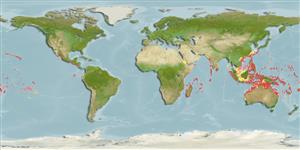Actinopterygii (ray-finned fishes) >
Perciformes (Perch-likes) >
Scaridae (Parrotfishes) > Sparisomatinae
Etymology: Calotomus: Greek, kalos, kallos = beautiful + Greek, tomos = section, cut (Ref. 45335).
Environment / Climate / Range
Ecology
Marine; reef-associated; depth range 1 - 72 m (Ref. 86942). Tropical, preferred ?; 30°N - 30°S
Indo-West Pacific: Kenya to at least Delagoa Bay in Mozambique, and east to the Marshall and Tonga Islands. Presence in Somalia to be confirmed (Ref. 30573).
Length at first maturity / Size / Weight / Age
Maturity: Lm 10.5 range ? - ? cm
Max length : 30.0 cm TL male/unsexed; (Ref. 48636)
Dorsal
spines
(total): 9;
Dorsal
soft rays
(total): 10;
Anal
spines: 3;
Anal
soft rays: 9;
Vertebrae: 25. General body color when fresh is greenish brown with scales finely flecked with pale; shade of white ventrally (belly sometimes dull rose or yellowish). Across the chin, 2 irregular dull reddish bars interspaced by white or yellow; upper opercular margin with a diffused dark spot. Hyaline pectorals with a yellowish flush; pelvic fins hyaline except for numerous small white spots and some reddish blotches. Flexible dorsal spines. Area circumscribed by pectoral fin unspotted. Lateral line interrupted (scales usually 19 + 7, occasionally 19 + 6).
Found in coastal bays and deep lagoons (Ref. 48636). Inhabits seagrass beds or dense beds of algae. Well-camouflaged and easily overlooked (Ref. 48636). Feeds on these or the associated epiphytes. Caught nets and other types of artisanal gear.
Life cycle and mating behavior
Maturity | Reproduction | Spawning | Eggs | Fecundity | Larvae
Spawning at Aldabra occurs above grassflats on falling tides; protogynous hermaphroditism with both primary & secondary males occurring in the atoll's population has also been reported (Ref. 1875).
Bruce, R.W. and J.E. Randall, 1985. A revision of the Indo-West Pacific parrotfish genera Calotomus and Leptoscarus (Scaridae: Sparisomatinae). Indo-Pac. Fish. (5):32 p. (Ref. 525)
IUCN Red List Status (Ref. 115185)
CITES (Ref. 94142)
Not Evaluated
Threat to humans
Harmless
Human uses
Fisheries: commercial; aquarium: commercial
More information
ReferencesAquacultureAquaculture profileStrainsGeneticsAllele frequenciesHeritabilityDiseasesProcessingMass conversion
Tools
Special reports
Download XML
Internet sources
